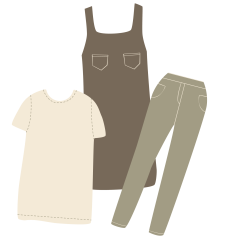Natural Fibres
Selecting natural fibres helps prevent microplastics from entering our ocean. As more people are becoming aware of the health risks of microplastics, they are choosing natural fibres for clothes and soft furnishings.

What you can do
Consider choosing natural fibres when selecting clothes and soft furnishings.
How can you do it
Fast fashion often relies on cheap fabric, but synthetic fibres such as polyester and nylon, shed tiny plastic fragments. Synthetic clothing is one of the main contributors to microplastics – there’s nothing stylish about that. Choosing timeless pieces made from natural fibres is a powerful way to support more sustainability in fashion and reduce microplastics.
Many people tell us they are switching to clothing and soft furnishings made from natural fibres such as hemp, silk, linen and wool, not only to reduce plastic, but also because natural fibres are breathable, durable, naturally hypoallergenic, and feel great against their skin.
Second-hand shops are a popular, thrifty way to purchase natural fibre clothes at a fraction of their original price. Buying second-hand also allows you to see how durable the item is after it has been worn and washed.
Another alternative to purchasing new clothing is to swap natural fibre items through established clothes swap events or informal gatherings with friends. This is a particularly good option for baby and children’s clothing that typically becomes too small when it is still in like-new condition.
Taking the next steps
Consider selecting natural fibres for other purchases such as hemp cushion covers, linen or hemp sheets, and jute rugs.
Before disposing of clothing, ask whether it may have another use. Old t-shirts and nappies (diapers) make great cleaning cloths.
Assist other people to select natural fibres by letting them know the natural fibre content of clothing or soft furnishings that you are selling or donating.
Consider reaching out to your favourite in-store and online brands and letting them know how concerned you are about plastic being added to the environment through clothing and packaging.
Some people have discovered how handy they are with a sewing machine or hand-sewing kit. Repairing or making your own clothes using natural fibres is a satisfying way to be more sustainable.
For one-off events such as formals or weddings, renting or buying pre-loved items is a practical solution.
The impact
- According to the Ellen Macarthur Foundation, a truck load of clothes is burnt or buried in landfill every second.
- By selecting natural fibres you are making a conscious decision to help prevent one of the major sources of plastic microfibres from entering the environment.
- Cheap synthetic clothing doesn’t just have an environmental cost. More people are becoming better educated about the human cost of exploitation in the global fast fashion industry.


